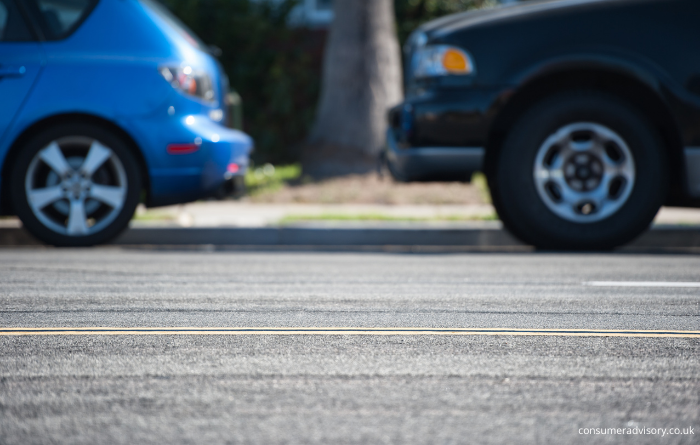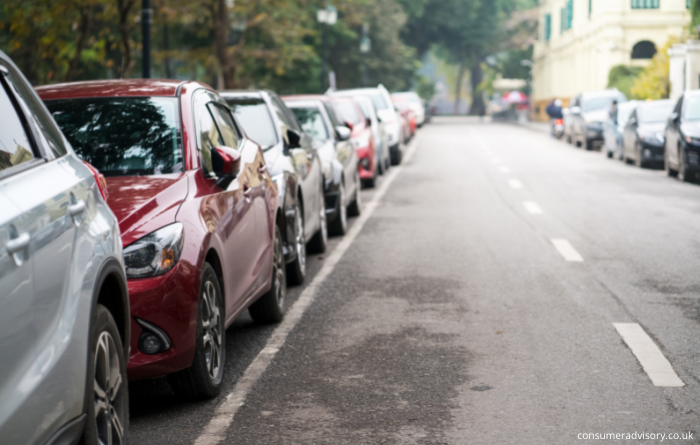
Single yellow line parking – what are the rules?
It’s not always easy to find somewhere to park, especially if you’re in a busy city centre or at a seaside resort. When you see a space at the side of the road with a single yellow line, it can be tempting to park there. But is it legal to park on a single yellow line, or could you be fined for doing so?
In this article, we’ll tell you everything you need to know about parking on a single yellow line, including when it’s legal to park your car here and the potential penalties you could face if you get it wrong.
If you see a single yellow line painted onto the road, it means that there are parking or stopping restrictions in force. You’ll need to check for signs to find out what those restrictions are and to work out whether you’re allowed to park or even stop your car there.
You may find that parking is only banned during certain hours or days of the week. For example, you’ll often find double and single yellow lines outside schools to prevent people from stopping their cars and blocking the school run in the morning and afternoon.
If there is a single yellow line painted on the road, you will need to look for a sign to give you further instruction. The sign will be yellow and will include the ‘no waiting’ road sign, as well as the times that this restriction applies.
This sign will tell you the times when parking is prohibited. This means that you are not allowed to stop or park on the single yellow lines during the times that are displayed on the sign.
If you can’t see a sign to tell you when the restrictions apply, you should always assume that parking is not permitted at any time and avoid stopping on the yellow lines.
When you see a single yellow line painted on the road, you should look for a parking restriction sign. This sign will tell you the days and times when you are not allowed to park on the street. This means that you are only allowed to park on the lines outside of the times displayed.
For example, if the sign says 9.00am – 5.00pm, this means that can park on the yellow line before 9.00am and after 5.00pm. If you decided to park on the street overnight, you must have moved your car from the line by 9.00am, or you could be fined.

Parking on a single yellow line is legal, but only outside of the restricted times that you will see listed on the yellow parking restriction sign. If you are caught parking on a single yellow line during the restricted times, you risk receiving a parking fine if you are caught by a traffic warden.
As a disabled badge holder, you have some additional rights when it comes to both single and double yellow lines. In general, you are permitted to park on single or double yellow lines for up to three hours, if it is safe to do so. However, there are some exceptions to this rule that you need to be aware of.
If there are restrictions on loading, you will not be permitted to park on the yellow line. This will be indicated by yellow dashes on the kerb, or signs that specify that loading is prohibited.
Additionally, you should not park on a yellow line within 15 metres of a junction, even if you display a blue badge.
When you park on yellow lines as a blue badge holder, you will need to display your parking clock to show the time that you arrived, as well as displaying your blue badge clearly. You are then able to remain parked on the lines for up to three hours from your arrival time.
If you want to park on a single yellow line, you’ll first need to check for the parking restrictions sign. This will tell you when you are not allowed to park on the line.
Sometimes the sign may permit you to park on the line at a weekend or on a bank holiday. However, it’s important to check the sign for the individual restrictions as they will vary depending on where you are.
When you see a single yellow line marked on the road, the first thing to do is check for a parking restriction sign. If you are outside of the stated hours, you will be able to load your vehicle on the lines.
Inside the hours, you are able to stop on the yellow lines to load or unload your vehicle, providing loading isn’t specifically prohibited. This means checking that any signs don’t specify that loading is not permitted and that there are not any yellow lines or dashes on the pavement.
You will also ensure that you are not causing an obstruction with your stopped vehicle.
When you stop your vehicle for loading, you’ll also need to ensure that you do not stop for any longer than necessary to load your vehicle. This is because your vehicle would then be classed as parked, which has different rules when it comes to single yellow lines.

It is illegal to park on a single yellow line during the restricted hours. Therefore, if you are caught parking on a single yellow line within the hours displayed on the parking restriction sign, you risk being handed a fine.
The fine for parking on a single yellow line is usually £70. This may be reduced by 50% if you pay within 14 days of receipt. However, the exact fine will depend on the local authority that you were in, with some areas handing out higher fines.
The terms ‘parking’ and ‘stopping’ are very similar and are often used interchangeably. But what is the difference between parking and stopping when it comes to the highway code?
You are considered to have stopped when you stop your vehicle to allow people to get into or out of the car, or to allow goods to be loaded or unloaded from the vehicle. The length of time that you are stopped is not taken into consideration, as long as you are not stopped for any longer than is necessary to load or unload people or goods.
In contrast, your vehicle will be considered to be parked if you stop for longer than is necessary to load or unload people or goods. Again, this does not take into consideration the length of the stoppage – even if you only stop for two minutes to set up your sat nav, you will be considered to have parked the vehicle.
Double yellow lines mean that parking, stopping and waiting are usually prohibited. The only exception to this will be if there are signs that specifically say that there are seasonal restrictions.

The majority of the time, you are not allowed to park on double yellow lines. However, there may be some rare instances when parking on double yellow lines is allowed.
You may sometimes see parking restriction signs that indicate that you are allowed to park on the double yellow lines outside of restricted times. These signs mean that you can park on the street providing it is outside of the stated window.
Additionally, blue badge holders can can sometimes park on double yellow lines for up to three hours. For this to apply, it will need to be safe to do so. This means that you will need to ensure that you are not within 15 metres of a junction and that there are no signs that restrict loading. You’ll need to display your parking clock to show your arrival time, alongside your blue badge.
If you see yellow lines painted on the kerb, you might be wondering what these mean and whether they’re the same as single or double yellow lines on the road.
Yellow lines on the kerb are used to signify that the loading and unloading of goods is prohibited within the times shown on the restriction signs. However, you are allowed to stop to allow passengers to get in or out of the vehicle.
If you park your vehicle on a double yellow line, it is likely that you will receive a fine in the form of a penalty charge notice (PCN). Outside of London, this will usually be £70. However, if you are in London, you could find yourself handed a fine of up to £130. This fine will usually be reduced by 50% if you pay within 14 days.
Many neighbours have disputes over parking, which may leave you wondering whether it is legal to park outside someone’s house. The truth is, there’s no law that prevents you from parking outside a house. However, there are a few things that you need to be aware of before parking your car.
Firstly, you need to ensure that there are not any single or double lines painted on the road. If this is the case, you’ll need to look for restriction signs to check whether you can park on the line.
You’ll also need to check for any junctions. This is because you are not allowed to park within 10 metres of a junction, or opposite a junction, unless there is a parking space marked out on the road.
Finally, you’ll need to look for any dropped kerbs. This is often the case where there is a driveway for the property. If you park across a dropped kerb, it could be classed as an obstruction which is legally enforcable.
The law states that you must not drive on or over a footpath, pavement or bridleway unless it is for the purpose of gaining lawful access to a property, or in an emergency. This means that you are not allowed to park on a footpath, unless there is a marked out parking space.
This is because driving on a pavement or footpath has the potential to cause danger to pedestrians, cyclists and other road users.
Whilst the majority of the time, you cannot park on a single or double yellow line, there are some instances where it is permitted. This usually applies if there is a sign that sets out certain times where restrictions apply. However, if you’re unsure, it’s always best to avoid parking on a yellow line. After all, this is the only way that you be sure to avoid potential fines.
In this article, we’ve explained single yellow line parking, exploring when you can and cannot park on these road markings as well as the difference between single and double yellow lines.
Copyright © 2025 Consumer Advisory. All rights reserved.